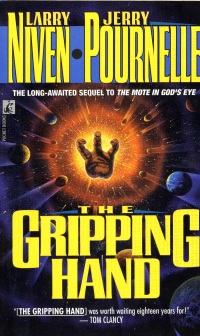
The Gripping Hand is the sequel to The Mote in God’s Eye. In some markets, it is also sold as The Moat around Murcheson’s Eye, which is a mouthful for a title but perhaps makes more sense. It was released in 1993, a full eighteen years after the first book was published. (George R.R. Martin fans might want to take note.) That’s almost as long as the time that has passed in-universe between the events of the two books.
The sequel centers around two characters from the first book. Kevin Renner who was navigator on board the INSS MacArthur during the mission to Mote Prime and Horace Bury, the trading magnate who initially saw the Moties as a tremendous money-making opportunity but later became terrified of them. The two are now agents of Navy Intelligence, with the responsibility of ferreting out rebel threats to the Empire while the Imperial Navy concentrates its resources on the Motie blockade.
Together with some other characters from the first book, the two eventually discover that a second Alderson Point out of the Mote Prime system will be opening soon. They race to respond, all the while knowing that the Empire is not strong enough to maintain two simultaneous blockades. The only solution is to negotiate with the Moties while presenting them with a way to control their high rate of reproduction. Fortunately on hand to assist them are the two children of Lord Roderick Blaine and Lady Sally Fowler who have the advantage of being raised by the Motie ambassadors sent into the Empire.
For all the anticipation behind the novel, I have to say that it is a much less interesting book than the first one. While it is in some ways better written and notably lacks the dated feel of the original, there adds nothing new of note to the Moties since pretty much everything that is interesting about them was revealed in the first book already. The entire first third of the book, while entertaining in its own right, ends up being only tangentially related to the main plot since it has nothing to do with the Moties at all.
The final third of the novel is basically an extended space battle. It’s also the best thing about the novel since the battle is depicted in terms of realistic physics. It’s like a slow-motion dance since it takes many hours for fleets to engage one another and the results are predictable long in advance because acceleration rates, energy levels and numbers of participants are all known.
Overall a strong space opera novel, but not the must-read that the first book was.